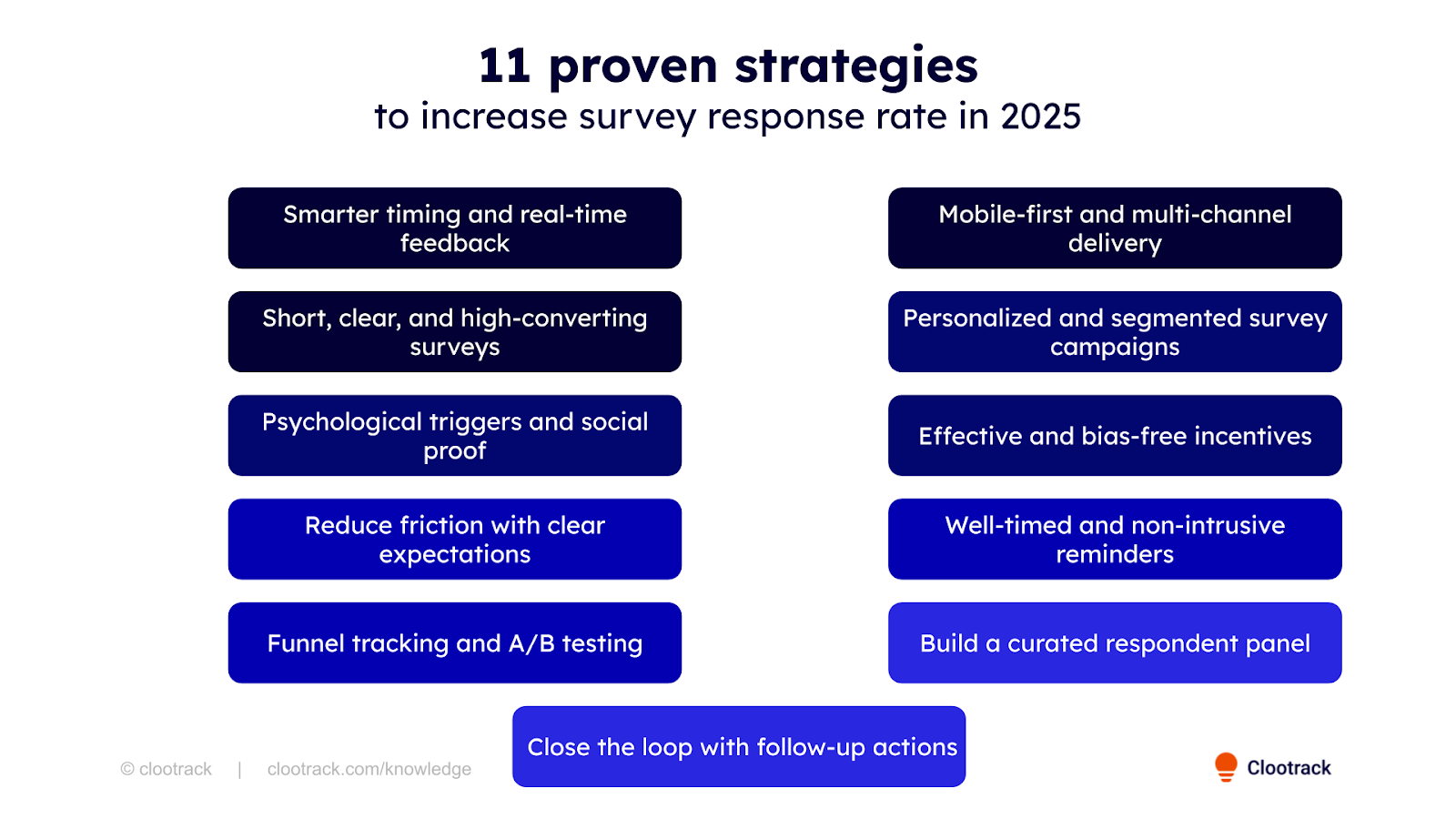🎉 Clootrack recognized by OpenAI for crossing 100 billion tokens in Voice of the Customer analytics →
Read the story

In 2025, the gap between high and low survey response rates is wider than ever. Some programs see as little as 3% participation, while others exceed 50%, depending on delivery channel, survey design, and timing.
For CX leaders, this isn’t just a numbers game—it’s a strategic risk. Low survey response rates distort customer insight, slow innovation, and undermine brand trust. To stay ahead, you need targeted strategies that balance reach with respondent effort, combining channel optimization, design best practices, and AI-powered analysis to capture high-quality feedback at scale.

Precision beats volume in 2025. Random outreach dilutes insight and undermines CX credibility.
These 11 data-driven strategies empower leaders to elevate survey response rate, delivering reliable feedback, stronger brand trust, and measurable customer experience improvement.
The moment you ask matters. Embedding real-time micro-feedback, such as emoji taps, one-question pop-ups, or post-chat ratings, into customer journeys ensures insights land when they’re most accurate and actionable. Research shows that immediate feedback is 40% more accurate than feedback collected just 24 hours later, enabling teams to address issues with greater precision. For instance, live feedback mechanisms let businesses catch and fix checkout glitches or service pain points instantly, before they snowball into churn.
This immediacy not only boosts engagement but also strengthens CX agility; leaders gain the clarity to act swiftly. When traditional survey response volumes drop, reinforce your understanding using AI-driven unstructured data analysis.

Note: Clootrack unifies survey feedback with unstructured sources like support tickets, chat logs, and reviews, using AI to illuminate sentiment and hidden themes missed by traditional surveys.
With nearly 58% of survey responses now coming from mobile devices, designing for mobile is essential. Plan channel use strategically from the outset.
Choose the mix that fits your audience, such as email for detailed surveys or SMS for short, transactional prompts. Multi-channel planning ensures you meet respondents where they are and build in flexibility for follow-ups later.
Long surveys kill completion. Stick to under 7 minutes or roughly 10–12 questions for optimal response. Keeping the survey to a single page can further maximize completions, while skip logic helps hide irrelevant content and shorten the path to the end.
Every question should be purposeful; avoid multi-part or ambiguous phrasing. Leaders value concise feedback because refining content improves both response volume and the quality of insights they can act on.
Generic outreach underperforms. Personalize invites using recent interactions, customer names, or segment-specific language to make them relevant from the first line. Personalized subject lines can lift email open rates by ~26%, which often translates into higher survey starts and completions.
Segment audiences by behavior, demographics, or lifecycle stage so each invitation feels timely and specific. Targeted outreach not only improves response rates but also ensures the feedback you collect is directly aligned with your CX priorities.
Emotional motivators work. Appeal to intrinsic motivators such as impact and belonging:
“Your insight matters.”
“Join thousands shaping our product roadmap”
These cues tap into a respondent’s self-perception and sense of belonging—two psychological triggers that consistently outperform monetary rewards.
Research in survey methodology shows that pre-notification from a trusted source can meaningfully increase participation. For leadership-driven CX programs, framing participation as a way to influence outcomes and be part of a community can lift response rates and improve the quality of feedback received.
Small, guaranteed incentives, like a $5 voucher, drive more responses than prize draws for boosting response.
Always explain why feedback matters and how it will be used. Clear incentives combined with transparency foster trust and responsible participation.
Be transparent about survey length upfront (for example, ‘about 3 minutes’) to reduce hesitation
Use friendly progress indicators like “Almost done!” rather than technical progress bars. This keeps respondents engaged emotionally and avoids abandonment.
Send a courteous reminder 2–3 days after the initial invite to lift completion rates, keeping tone respectful and concise. Where possible, vary the reminder channel from the original invite (e.g., follow an email with SMS) to avoid fatigue and reach non-responders more effectively. Research shows that well-timed reminders can significantly increase response without eroding goodwill.
Track key stages: Invitations Sent → Survey Started → Completed.
Use A/B testing for subject lines, send times, and CTA wording to systematically uncover what resonates. This iterative refinement aligns survey tactics to leadership objectives over time.
Rather than relying on one-off blasts, build and maintain a pre-engaged panel of customers willing to provide feedback on an ongoing basis. Well-managed panels deliver consistent, high-quality input, reduce recruitment friction, and enable faster turnaround for new surveys.
Closing the loop is foundational. Always share how feedback was used and reinforce value:
“Your feedback contributed to our new checkout experience.”
“Based on your input, we added Feature X.”
Organizations practicing this transparency see dramatically improved repeat engagement.
Communicate changes via newsletters, dashboards, or personalized notes. This validates respondents and positions your CX strategy as responsive and trustworthy, central to leadership credibility.
To lead effectively in 2025, survey strategies must be smarter, not louder. Prioritize mobile-first design, optimal timing, personalization, meaningful incentives, and clear communication. Balance these with deep analysis and consistent follow-through. When direct feedback slows, supplement with AI-driven insights from Clootrack to keep strategies rooted in real customer understanding.
Ready to see how it works? Request a demo today.
Launching an awareness campaign before the survey helps set expectations and increases willingness to participate. Informing audiences via newsletters, intranet posts, or internal champions can lead to higher engagement. One strategy involves appointing “survey champions” in departments to actively promote it, even dedicating time for completion during work hours, solidifying institutional buy-in and clarity.
Using sequential mixed modes, such as combining email or web with follow-up telephone or mail, has been shown to increase response rates by 2–5 percentage points, while also improving representativeness across customer segments (e.g., older or underrepresented groups).
Absolutely. Embedding icons, symbols, or images in surveys, especially long ones, can break monotony and reduce cognitive load. Design elements relieve fatigue and help maintain engagement, particularly in more extensive surveys.
Yes. Reframing a survey away from formal “report card” language and toward actionable messaging, like “help us improve” rather than just “assess performance”, reshapes participant mindset. This approach aligns feedback with change, not judgment, making respondents more likely to engage.
Conversational surveys delivered via chatbots, using natural, open-ended questions, drive high engagement and richer responses than traditional formats. One study showed that chatbot-based approaches elicited clearer, more relevant, and more specific answers, thanks to their adaptability and dialogue flow.
Analyze customer reviews and automate market research with the fastest AI-powered customer intelligence tool.
